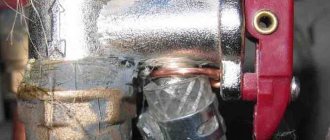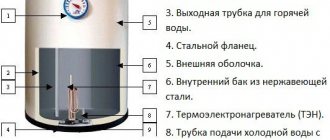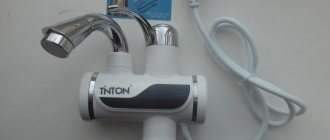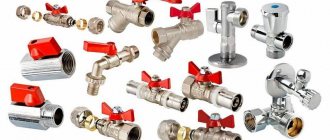Hot water supply is a service without which modern residents of both multi-story and one-story buildings can no longer imagine their lives. Individual DHW systems are increasingly covering the public sector, since the centralized supply of hot water is either of poor quality or non-existent. You can imagine the level of disappointment and shock for a boiler owner when a tank suddenly explodes in his home. In fact, such a situation happens extremely rarely and, most often, is caused by improper piping of the device or a defective safety valve. However, the owner of a heating device needs to understand the causes and consequences of an explosion so that it can be prevented.
Reasons for the explosion of a storage water heater
According to the principle of operation, a boiler is a large kettle, except that it is not designed for boiling. The maximum water heating temperature in it is 55-80 C. Next, the first level of protection from the thermostat, which is set by the user, is triggered. At a coolant temperature of 95 C, the second, built-in temperature sensor turns on, turning off the power supply to the heating elements. If for some reason the protection does not work, the water will overheat and at a temperature above 100 C it will begin to boil with the formation of steam, which has a larger volume than hot water and an increase in pressure in the container, until the tank explodes, after which the steam will burst into the room.
There is a more benign scenario for the accident if the boiler is tied with polyethylene pipes. In this case, they will simply be torn out of the pipes by high pressure, and the tank will remain intact. Thus, we can distinguish three main reasons preceding the explosion:
- Incorrect boiler piping;
- violation of the manufacturer's instructions;
- failure of elements of the protection system.
Incorrect installation
Before installing the boiler, you should definitely study the manufacturer’s instructions for installing and operating the device; if something causes difficulties, it is better to invite specialists. For many Western brands, installation by service departments is a prerequisite for the product to have a warranty.
In addition, installation performed by a certified organization under an agreement with the owner also has a guarantee and in the event of accidents due to the fault of the installation organization, all losses will be compensated at its expense. Structurally, the boiler is designed in such a way that the water inlet and outlet pipes are clearly fixed and have a color designation: the cold water inlet is blue, and the hot water inlet is red, if they are mixed up, the boiler will overheat, followed by an emergency exit. building.
The boiler must include a safety valve; it is designed to protect the device from excess pressure in the range: 6.0 – 10.0 MPa. Structurally, the valve has cylinders united by a common cavity and perpendicular to each other. Inside the larger one, a poppet valve with a spring is installed to allow free movement of water in only one direction. This part of the structure functions as a check valve, and the second smaller one is plugged on one side and has a drainage hole through which water is discharged when the pressure in the vessel increases.
Such a protective device is installed in front of the heater, without valves along the cold water flow. If the valve is not placed according to the diagram indicated by the manufacturer, then an emergency situation may develop, which cannot be allowed, since a boiler explosion is similar to the power of 300 g of TNT.
Protection doesn't work
If the user notices that the water heater tank is swollen, he must immediately turn it off; such a failure occurs due to a broken thermostat. Modern electrical devices have two sensors. If one fails, the second blocks the operation of the system when the water temperature rises from 95 C.
The safety valve can break for a number of reasons: it is clogged with scale, stuck, has natural wear, or has lost its tightness. Sometimes the user unknowingly closes the protective device himself in order to save water. Such “frugality” can lead to an accident.
Water heater design
Water heaters are widespread household devices designed to heat water in a house or apartment. Based on the type of fuel used, water heaters are divided into gas, electric, solid fuel, and liquid. Due to some peculiarities of the functioning of the water supply (frequent lack of hot water in the tap, insufficiently high temperature of the supplied water), in the apartments of many multi-storey buildings, residents have installed electric water heaters, called boilers. Storage water heaters (those in which water is collected in a tank and heated for several hours) have become widespread. They consume significantly less energy, unlike flow-through devices. An apartment resident can install water heaters himself, but it is necessary to know some features of the design and operation of the system in order to prevent an accident (a situation in which the water heater exploded or the communication connection was broken).
Electric boiler connection diagram.
The water heater includes a tank (the container in which heating occurs) and service devices. Two shut-off valves are located like this: one at the cold water inlet, the second at the hot water outlet.
Thermostat is a device that blocks heating of the water heater above the set temperature.
Non-return safety valve - installed on the incoming cold pipe and consists of two valves. The first (reverse) prevents water from the tank from returning to the cold water supply system (when there is temporarily no water in the cold water supply). The second (safety) should open slightly and drain water if there is excess pressure in the system. The safety valve begins to drain through a special drain hole when the pressure in the system exceeds 6 atmospheres.
Water heater design diagram.
You need to know that bleeding can occur not only in emergency situations. Working discharge of excess water can occur when the water heater heats up. An increase in water temperature is accompanied by its expansion; when heated to 90˚C, the volume of water increases by 3%. This means that a 100-liter boiler may contain 3 “extra” liters of water. In quality water heaters, space is provided in the tank for expansion so that excess water during heating can take up this additional volume. When the additional volume is not enough, a working drain of water (not an emergency) occurs through the safety valve. To make draining easier, put a tube on the valve to drain it into the drain or place a container underneath.
Article on the topic: Cucumbers on the balcony: agricultural technology for growing
Pressure reducer - installed at the inlet to adjust the pressure (usually the boiler design is designed for water pressure at the inlet to the boiler of up to 3 atmospheres).
A drainage system can be built into the tank to empty the tank when necessary.
In the boiler operation system, two important devices are provided to protect against a possible accident.
This is a thermostat and safety valve. An accident in the operation of a water heater (pipe rupture or explosion) occurs when both safety devices are faulty. If, when heated to the set temperature, the heater is not turned off by the thermostat, the water in the tank boils and the pressure rises. Excess pressure not relieved by the safety valve can tear the inlet (outlet) pipes from the water heater or rupture the water heater itself.
Destruction of the instantaneous water heater housing
The specifics of operation of flow-through heaters differ significantly from storage heaters, however, they are also susceptible to explosions. There are closed and open flow units. The latter are connected to a closed cold water supply system to provide hot water supply at one water intake point. Closed units are included in a common riser circuit and supply hot water to several water points simultaneously. A situation with a system explosion can occur if the temperature sensor does not work or if it is jammed. A user who discovers that the sensor is not working and cannot adjust the temperature must stop the heater and replace the sensor.
An emergency situation can also arise when the boiler has a shower hose and it is accidentally pinched; in this case, the flow switch does not work, the pressure rises sharply above the permissible level, causing the housing and pipe system to rupture. Sometimes the thermal protection of the heater does not work, since the heating process is activated by a button. If it is turned on and the supply valve is not open, then the water in the housing overheats with subsequent destruction.
How does a gas water heater work?
The term “gas water heater” is a legacy of the Soviet period. In those days, when hot water supply was just being established, during the construction of houses, simplified wall-mounted gas boilers were installed in apartments, not equipped with automation and security systems.
Morally, technically and technologically outdated units were inconvenient and dangerous. Modern equipment is radically different from its ancestor. The devices are convenient, beautiful and do not pose any threat to the health and property of the owners.
Geysers can be manual, with piezo ignition and electronic ignition, equipped with sensitive sensors that interrupt the fuel supply in case of extinguishing
Instantaneous gas water heaters are a metal structure with a heating system. Pipes are connected to it for cold water inlet and hot water outlet, for coolant circulating through the heat exchanger, as well as for gas. The igniter is located at the bottom of the equipment. It functions like a lighter.
The gas valve opens automatically immediately after turning on the water or activating the heating process of the coolant. Gas enters the main burner, which is ignited by the igniter and produces heat. The water enters the heat exchanger, which is a spiral tube, where it is prepared for supply to the heating circuit or to the hot water supply.
Hot water is already flowing into the water tap. It heats up within 2-3 seconds after turning on the burner. Its temperature depends on individual settings. To remove combustion products, a chimney is required.
Precautions against boiler explosion
In order to protect yourself and your loved ones from possible injuries, the user should always monitor the operation of the water heater. Elements and components of the boiler that is being monitored:
- Heating light alarm, during the heat transfer process, they control whether the LEDs are lit or not, as well as the time the thermocouple is turned on and the thermostat is turned off.
- If the thermostat fails, the power supply to the device is turned off. Wait for the device to cool down naturally. It is forbidden to open taps on an overheated device, as you may get scalded by the steam.
- Monitor the operation of the safety valve; when the boiler heats up, it should drip a little.
- It is better to piping the boiler with polyethylene pipes. In case of overheating, they will take on the load and the storage tank will not be deformed.
In the room where the water heater is located, it is recommended to install plastic windows, which in the event of an explosion will take on the entire load, and the walls will be preserved.
In the practice of preparing hot water through water heaters, a tank explosion is an isolated incident. It can be avoided; you only need to strictly follow the installation and operation rules prescribed by the manufacturer.
Why are water heaters dangerous?
Prices for water heaters in our store
Risk of explosion of a storage water heater due to increased water pressure
Gas explosion during operation of a gas water heater
Burns from scalding or scalding
Biological threat
Electric shock
In pursuit of profit, many sellers of water heating equipment tell buyers only about the advantages of using their equipment, without bothering to inform the buyer about the dangers of using water heaters. In fact, when operating a water heater, it is imperative to take precautions against the possibility of water heater explosion, burns, water contamination with bacterial colonies, electric shock and gas leakage.
Risk of explosion of a storage water heater due to increased water pressure
A storage water heater, being a pressure vessel, can explode, causing significant damage, posing a threat to the health and life of people, if a safety valve is not installed during installation.
Wall-mounted storage water heaters with a capacity of up to 200 liters must use a non-return safety valve, which is a combination of a non-return valve and an overpressure relief valve. It is installed on the inlet pipe of the water heater (for cold water).
Large volume floor water heaters use a T&P or TPR type safety valve - a protection valve against excess pressure and temperature. It is installed in the upper part of the tank separately from the cold and hot water pipes.
Both the non-return valve and the T&P valve have a water discharge connection. It is desirable that this pipe be connected to the sewer.
The photo below shows the result of an explosion of an electric storage water heater with a capacity of up to 100 liters.
Gas explosion during operation of a gas water heater
According to Rosgazification, about 230 incidents related to the use of gas in the home occur annually in the residential sector. An average of 130 people die.
The largest number of deaths and accidents occur when using instantaneous water heaters with faulty chimneys, gasified heating and cooking stoves with a closed gate, the safety automatics of which do not ensure timely shutdown of the gas supply in the event of a loss of draft or extinction of the flame.
For any room to explode, it is enough to fill it with gas only 5-15 percent, and the consequences will be catastrophic. The reasons for the explosion of a gas water heater are violation of operating rules, the formation of an explosive concentration of gas-air mixture in the room as a result of the extinguishing of the burner flame or leaks in pipe connections.
The photo shows the result of a gas water heater explosion.
To avoid gas explosions, learn and follow safety regulations when operating gas appliances.
Burns from scalding or scalding
Any water heater can cause burns. A person can get burned quickly at a temperature of 60 ºС (within 5 seconds) and much more slowly at a temperature of 53 ºС (about a minute). Old people and children often suffer serious burns due to their frailty and slow reaction time. To avoid the possibility of burns, it is recommended to install mixing valves at the outlet of the water heater.
The mixing valve mixes cold water with hot water so that the user receives warm water from the water heater at a temperature of no more than 50 ºС. If there is no thermal mixing valve, then the risk of burns can be reduced only by reducing the heating temperature of the water in the water heater. However, according to sanitary standards, it is required that the water in the water heater be heated to a temperature of at least 55-60 ºС.
Biological threat
Two conflicting safety concerns affect water heater water temperature: the risk of scalding from overheated water and the risk of bacteria, particularly Legionella, colonizing in water that is not hot enough to kill them. Both risks are potentially life-threatening. It is believed that it is necessary to maintain the water temperature in the water heater at 60 ºC and distribute it through pipes with a temperature of at least 50 ºC, and preferably 55 ºC, in order to avoid the risk of Legionella.
However, water temperatures above 60 ºС promote the formation of scale, which can subsequently cause the appearance of bacteria. Also, at a temperature of 60 ºС, increased corrosive wear of the internal tank of the water heater occurs.
The appearance of leginella can be avoided with the right engineering approach. For example, raising the water temperature in the water heater to 55 ºС for half an hour once every one or several days.
Electric shock
Since water is an excellent conductor of electricity, water and electricity form a very dangerous combination.
An electric shock with a voltage of 220 or 380 V can easily be fatal to a person in the bathtub.
Electric shocks to water are possible if the water heater is not grounded, or is grounded incorrectly or poorly. It is also possible that the cause is a faulty heating element in the water heater.
Unprofessional connection of an electric water heater, as in the photo, can cause electrical injury.
To protect against electric shock from an electric water heater, it must be reliably grounded and connected through an RCD rated 10-30 mA. In addition, an excellent protection against electric shock is the potential equalization system.
You can find out how to properly ground bathroom equipment here.
Source: teplo-spb.ru
Source: https://teplo-spb.ru/stati/kak-eto-rabotaet/chem-opasny-vodonagrevateli.html
Explosion warning. What should be done?
By following just a few simple rules, you can avoid situations that lead to a boiler explosion, and also prevent other possible emergency breakdowns of the water heating system. So:
1. It is very important to connect the household unit correctly;
2. Constant monitoring to ensure that the water heater is working correctly (no unnecessary shutdowns, normal operation of heating lamps, etc.).
And further. Each boiler has an individual time during which the water heats up to the maximum value. And as soon as this time is over, the thermostat should turn off via a thermocouple. But if the thermostat is broken, the water heater will not be able to turn off and this will lead to its explosion. In such a case, it is necessary to turn it off immediately.
And under no circumstances should you drain hot water. The high pressure that has built up in the water heating system increases the boiling point. Therefore, draining the water will lead to a decrease in internal pressure; unboiled water will boil, forming a lot of steam, and the unit may explode.
Thus, the only thing that is required of you in such a case is to turn off the boiler so that it cools down and wait for a specialist to arrive.
How to prevent an emergency
Follow these simple rules:
- Install equipment correctly.
- Monitor the operation of the device. Look at the panel: the indicators will tell you whether heating continues or not. If, after the time has passed, the heating element continues to work, disconnect the boiler from the network. Don't flush the water! This way the pressure will drop sharply, and the boiling will become even more active. Just wait for the master to arrive.
- Check and replace the safety valve in a timely manner.
- Make connections through metal-plastic pipes. They are mounted through fittings, so the connection breaks when there is excess pressure. Whereas plastic or metal pipes have threads. Then the tank is more likely to explode.
The most important thing is to buy high-quality equipment for your apartment. Its manufacturer provides the proper protection system, so you don’t have to worry.
A visual experiment on a heater explosion:
What other problems might arise?
Fixing the consequences of a burst water pipe will cost you much less than the consequences of an explosion of the boiler itself. But if you try, such situations may not arise.
Failure of the pipeline will lead to the flow of water, the amount of which will increase all the time. Next, hot water will begin to flow out of the water heater. Repairing the unit and finding out the reasons for water overheating can only begin after the tank of the device is completely empty and the room is well ventilated. But if the pipes have a reliable and high-quality connection to the boiler, then they may not break. Instead, due to the growing intra-system pressure, the heater itself will explode, bringing with it the following devastating consequences:
- a household appliance can no longer be repaired after an explosion;
- everything around, including doors, furniture, walls, tiles, water and gas communications, etc., can be damaged to the point where repairs will no longer help.
It is very important not to forget that it is much easier to prevent an explosion than to eliminate its consequences later. And to do this, control the operation of your household appliances. And do not forget about regular maintenance and timely repair of the water heater. We provide service and repair of Ariston, Termex, Timberg, Garanterm and other brands.
Video of water heater explosion
And for dessert, a video of a cauldron explosion from MythBusters.
anode
22.03.2017, .
| Maintenance of water heater from 30 to 100 liters 1000.00 rub. |
| Maintenance of water heater from 120 to 300 liters 2000.00 rub. |
| Calling a technician to diagnose and repair a water heater within the city of Yekaterinburg RUB 1.00. |
By submitting any form on the site, you agree to the privacy policy of this site.
source
How and why boilers explode
Trust your climate to professionals!
3 reasons why a boiler explodes
Hot water supply is an important component of a person’s comfortable life. Due to the fact that interruptions often occur with it, many refuse centralized supply and install a boiler. Owners of private houses also choose a water heater.
Once you install the equipment, you will forget about constant shutdowns and other troubles. If you choose a normal Gorenie boiler of 50 liters or more (it all depends on your needs), hot water will be provided for many years.
But in some cases there are situations where you bought an expensive water heater, but it simply exploded after a certain period of use. It is clear that repair is impossible, you need to go buy another one. You've already had your eye on a new model, but you still wanted to know what caused the water heater to fail. I didn't want the situation to repeat itself.
Why did the boiler explode?
A water heater explodes for 3 main reasons:
- incorrect installation;
- violation of the terms of use;
- failure of main parts.
Since the water heater itself is expensive, many try to save at least on its installation. They invite friends or try to do everything themselves. Only a few understand the intricacies. As a result, mistakes are made that lead to negative consequences.
The service life of the boiler depends on correct use. Few people even periodically monitor the heating indicator. During normal operation it should turn off periodically. If overheating occurs, a huge amount of steam will form inside, which will cause the tank to rupture.
Another reason is the breakdown of some parts. Without a broken safety valve or thermostat, the equipment heats up non-stop. In such cases, an explosion cannot be avoided.
A word of advice: look for a model that has two thermostats. If one breaks down, the other will work and turn off the system, preventing the water from boiling. And this will protect you from an explosion.
Remember, a water heater explosion is an isolated incident, but it still happens to many. It can be avoided if you adhere to basic rules of use and do not skimp on installation.
When purchasing a boiler through the Sp-climate online store, consultants will tell you everything in detail. They will also tell you how often you need to invite a technician for a routine inspection in order to prevent possible breakdowns. Let there never be any shortage of hot water in your home again.
source
What needs to be done to prevent the boiler (storage type) from exploding?
Well, first of all, you need to study its structure in order to have an idea of the processes occurring inside this mysterious barrel.
I agree, a boiler explosion is a very rare occurrence, but still possible (pah-pah-pah). And very destructive in its power!
There are two very important elements that should protect your boiler from exploding:
– safety valve to reduce intrasystem pressure;
It is very important that at least one of these protection elements remains in good condition!
After all, a thermostat is needed in order to control and prevent the water temperature from exceeding the value you set, and a safety valve is designed in case the thermostat fails to cope. In this case, the water will begin to boil and you will need to apply excess pressure somewhere, which can rupture the working container. It is this task that is assigned to the safety valve, which is designed for a certain pressure, the excess of which leads to its operation and the release of the increased coolant volume.
If it happened that both the protection elements did not work, then two scenarios are possible:
– will break the pipe (which, of course, is more preferable)
– Of course, it is very important to install everything correctly, connect
. Do not neglect the instructions, even if you are used to completely relying on your own skills and experience. Boiler models are different, with their own characteristics.
– Of course, constant periodic monitoring
operation of the system, this is one of the main conditions for its safe operation. You can't rely entirely on technology! I had a case when I took an ordinary oil heater to a service center for repairs, and there, instead of replacing some failed element (I don’t remember exactly what was there. A lot of time has passed), they stupidly “cut it out” it from the circuit by twisting the two terminals together! And this is in the service center!
– Choose a quality device.
You need to save where this saving will not lead to serious consequences, under any circumstances! Miser pays twice. A high-quality boiler is distinguished by the presence of a pair of thermostats that regulate the maximum temperature of the coolant.
– The emergency pressure reduction valve must be periodically checked for functionality.
(must be dredged occasionally when heating the boiler). And replace it approximately every two years.
– Use metal-plastic pipes
, because the connections there are fittings, and if the pressure in the system exceeds, it is in these places that a rupture will occur, which will reduce the pressure, avoiding an explosion.










